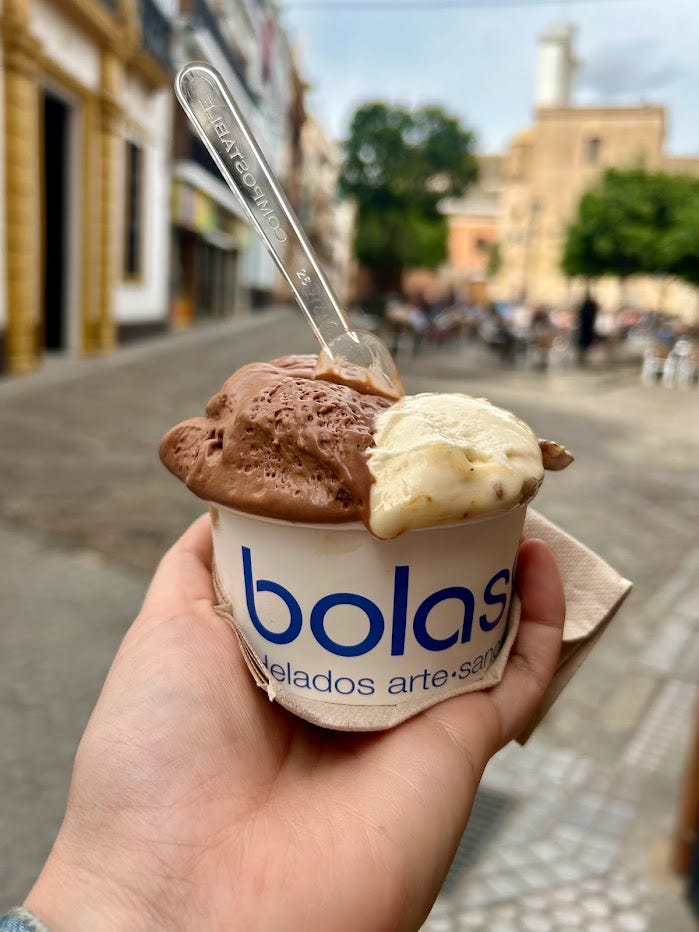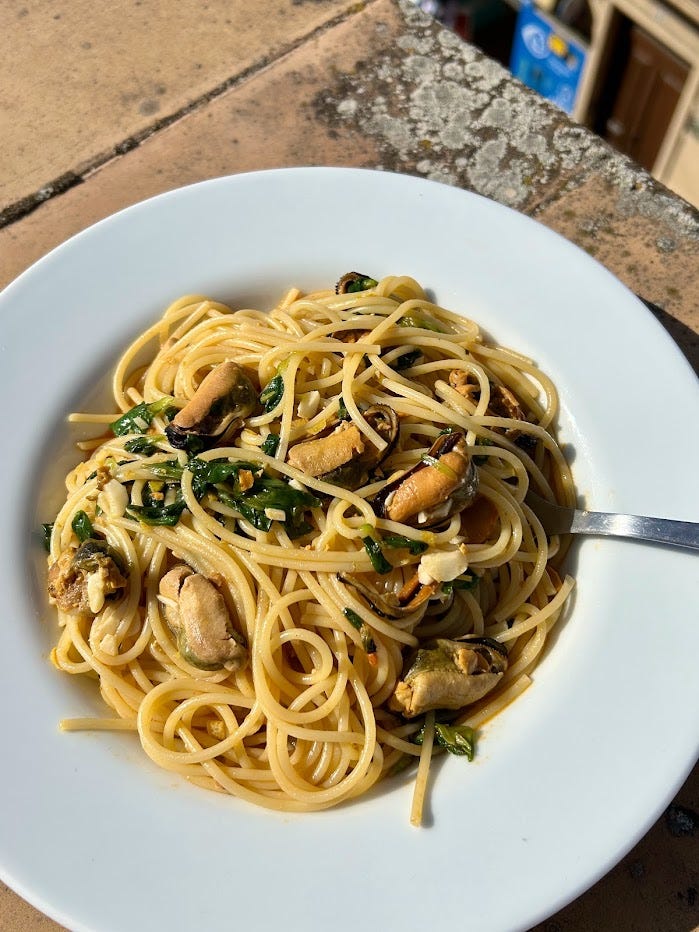Hi all,
I’m writing today from the train between Seville and Barcelona, headed to see friends for the next couple of days after a week on my own working and exploring in the Andalusian region. This week has been smooth so far - I’ve done a lot of remote working over the past several years and some trips have been more chaotic than others, but I think I’ve honed my strategy at this point and now do a few things intentionally in order to help the trip be successful. The key, I think, is to think of this as your normal life but better. This is not a touristing holiday, this is not you holed up at home working from the same desk you’re at every other day of the year, this is somewhere in between those two, experiencing an everyday lifestyle in a place that is new and exciting to you.
Since this is a food newsletter I’m going to mainly focus on food-related tips for successful remote work, but if this topic is useful to you let me know and maybe I’ll write up some more in a future issue.
Stick to your normal routines as much as possible. If you always eat the same thing for breakfast, buy that at a local grocery store so you have it already in the mornings before you start work. If you listen to the news or podcasts on a regular schedule, put them on as you would for a normal work day. If you have a skincare routine, bring as much of it as you can and keep it up. If you work out regularly, find ways to fit that into your schedule or adapt your exercise to walks/runs around the new city. Keeping the foundations of your normal lifestyle stable will help you feel healthier and less tired as you add in new experiences in this new place. And drink a ton of water!!!
Stay near where you’ll be eating. I’m a big Google maps gal, I love to flag every restaurant and spot I want to eat in a new city beforehand, and I read all sorts of review sites and talk to any friends who may have recs in order to find those places. I now do this before I even book where I’m staying, and then I look at where those flags are consolidated and try to stay somewhere in the vicinity. Too many times I have finished dinner in an unfamiliar city and realized I needed to figure out how to cross town in the dark in order to make my way home. Especially in the middle of a work week when I’m trying to maintain a relatively normal schedule, it’s so much easier (and safer) if I can just stroll a few streets home at the end of the evening instead.
Stay somewhere with a kitchen. One of the most tiring parts of travel is going out to eat again and again, including needing to search for a decent place 2-3+ times per day which will fit your schedule and serve what you’re looking for. Having a kitchen means you don’t have to make those decisions so often, and you can have quicker, more casual meals at home when you’re not looking for a whole restaurant experience (and also don’t need to rely on fast food). Of course I LOVE going out to restaurants and tasting the specialties of the area, but not every meal needs to be out - it’s ok for lunches, or even some dinners to be at home, giving you time to relax just like you would in your normal life. As a bonus, this gives you the chance to try cooking with local produce and ingredients that you might not have the chance to otherwise.
Shop where the locals shop. You’ll find better prices, and often far better quality. Check out farmers markets, regular grocery stores, local bakeries, fishmongers, butchers, etc., and you’ll find what you need to cook at home, plus it will be a fun way to experience local life. I love to peruse the shelves of a supermarket in another place - this week I bought a ton of tinned fish to cook with and bring home as souvenirs at a fraction of the price they were selling for in touristy areas, and certainly back in London.
Buy the basics and then supplement with fun local products. It’s a tough balance when you’re traveling to buy enough groceries to hold you through the week, but not so much that it’s going wasted when you leave. The basic formula I’ve come up with is to buy cooking essentials (olive oil & salt, often they already have these available in the kitchen), breakfast supplies, a simple protein that can be flexed to different types of meals (eggs, yogurt, beans, tofu, etc.), a carb base (pasta, rice, bread, etc.), and some easy adaptable flavor enhancers like lemon and garlic. From there, I’ll choose a few things that look interesting to me from the local markets and build my meals around those. Try out the produce that’s especially in season where you are, pick up fresh bread from a local bakery, give a few of the specialty ingredients a try that you don’t have access to at home - this is the fun of it!
If you like to travel and work remotely, do you have any other advice for making the most of a new place while also staying productive and not exhausting yourself? I learn something new from every trip, so I’d love to hear any other tips you’ve picked up that have helped make your travels more successful.
Tinned fish pasta
One of my meals in my rented apartment this week was a version of a pasta I make often, which is perfect for situations when you have very few ingredients but want to eat something nice. I made it at home on Valentine’s Day just before I left for travel, because I didn’t want to buy any new groceries. And I made it again this week in Seville, because I had limited food but one thing I did have was all sorts of cool tinned fish that could give this a fun new twist.
Call it pantry pasta, call it amped-up aglio e olio, practically every home chef has a version of this which they’ll go to when the kitchen is sparse. More of a formula than a true recipe, this is something you can really make your own and adapt to whatever you like and have on hand. The quantities are all to your own taste, so make it spicier/tomatoey-er/greener/etc as you prefer, or don’t. In terms of the fish, the easiest and reliably tasty option would be anchovies, which I recommend having in your pantry at all times anyway. If you’re wary of them, don’t worry - they melt completely into the sauce so you’ll never even know they are there when you’re eating except for that your pasta tastes better than anything you’ve made before. If you really don’t like tinned fish, fine, leave it out, it’s your pasta anyway!
Core ingredients:
pasta (I like a long pasta like spaghetti for this but any will do)
salt (for the pasta water)
olive oil
minced garlic
fresh lemon juice
The above mixed up and nicely emulsified into a sauce (see method below) would be lovely on its own, a lemony version of aglio e olio. But for a real treat, add any or all of these extras:
tinned fish packed in olive oil (anchovies would be easiest, but mussels, clams, crab, whatever sounds good to you. If it comes with a flavored oil you like, even better)
chili (fresh minced red chilis, dried chili flakes, paprika, or aleppo pepper would all be nice)
something green (fresh herbs, chopped leafy greens like arugula or spinach, etc.)
more alliums (sliced or minced shallots, minced red or white onion, or sliced scallions)
tomatoes (chopped fresh tomatoes and/or tomato paste)
butter (just a dab makes the whole thing creamier)
Method
Cook your pasta in salted water until close to al dente - it should still have a bite to it and will cook more when you toss it with the sauce. If the pasta finishes before the sauce is ready, reserve a large cup of pasta water and then drain.
Open the tin of fish and try a taste of the oil it’s packed in. If you like it, drain it into a sauté pan and turn on medium heat. If it’s not your thing, use a couple of tablespoons of regular olive oil instead. Add the minced garlic and chili and let sizzle until fragrant. If you’re using anchovies, add these now and let them melt completely into the oil. If you’re using another type of fish, wait until after the pasta to add to the pan.
If you’re using tomato, more alliums, and/or greens, add these now along with a pinch of salt and mix until the onions are translucent and greens are wilted, mixing well.
Add your al dente pasta to the pan along with a splash of cooking water, and mix vigorously to emulsify the sauce. If it seems too dry, add more pasta water. If it’s too wet, keep mixing and let some evaporate. Keep adjusting with the pasta water until your sauce comes together and clings to the pasta.
Add the tinned fish to the pasta (unless it was anchovies and went in earlier), and mix. Depending on the type of fish you might want to break it up thoroughly into the sauce, or for something like mussels or clams you’d want to be more gentle to keep them intact. Mix just until fish is warmed through.
Turn off the heat and add a small pat of butter, letting it melt in and make everything creamy as it’s mixed through. Finish with a large squeeze of fresh lemon. Taste, adjust the salt or acid as needed, and serve.
Have a great week,
Susanna







